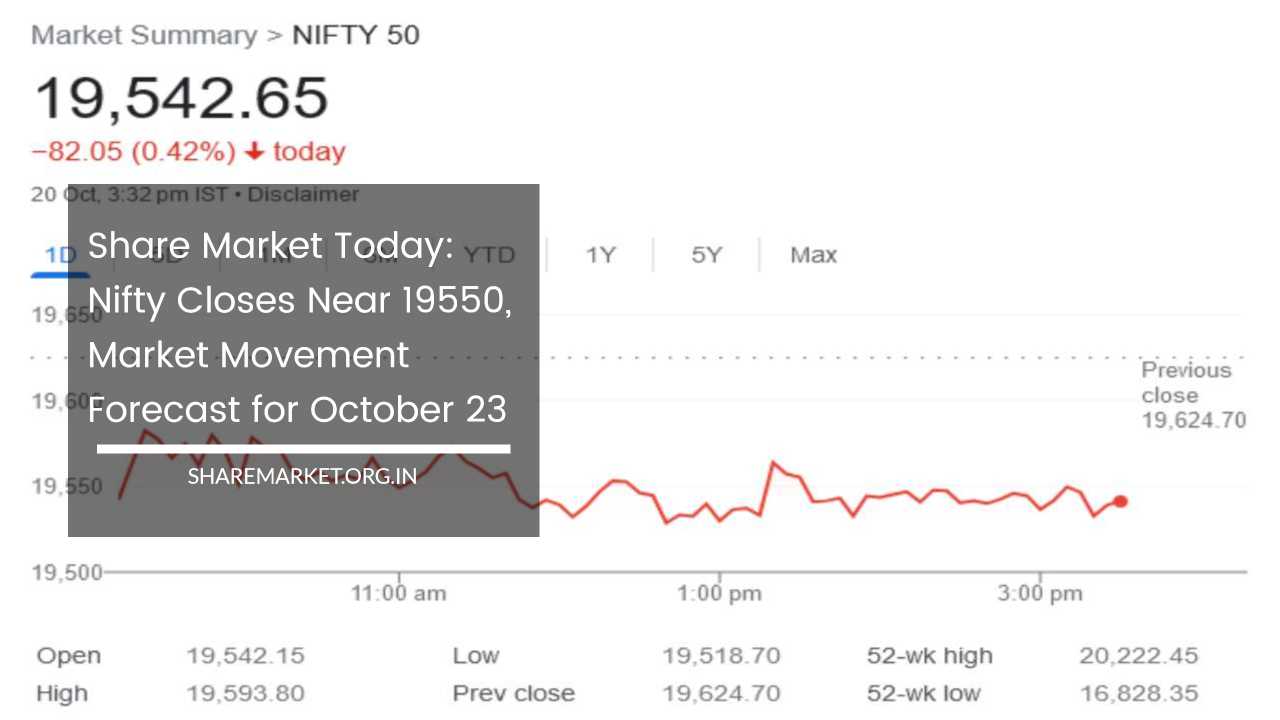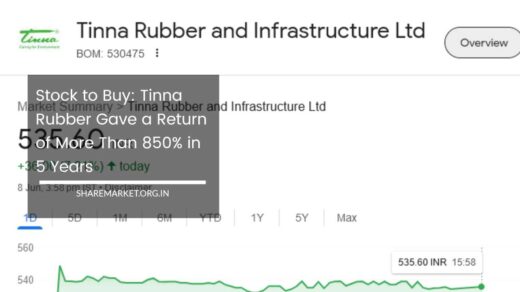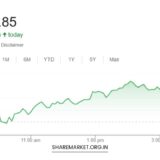Share Market Today: Nifty Closes Near 19550, Market Movement Forecast for October 23

Share Market Today
In the ever-evolving landscape of the stock market, it’s crucial to delve deeper into the key support and resistance levels to gain a more comprehensive understanding of the current market conditions.
Immediate support for Nifty is a critical marker, standing firm at 19,500. This level represents a significant threshold, one that, if breached, could usher in a period of uncertainty.
Should Nifty stumble below 19,500, traders and investors need to brace themselves for the possibility of a bearish movement taking control.
The range of 19,150 to 19,000 becomes an ominous prospect, one that might become a harsh reality in such circumstances.
Conversely, there is a formidable resistance zone on the upside, spanning the range of 19,600 to 19,650. This upper threshold represents a crucial point of contention, where market forces could either break free into a bullish rally or continue the struggle with the bears.
Market Performance:
The stock market has experienced a notable downturn, marked by a consistent decline over the past three trading days. On October 20, Nifty concluded the trading session at approximately 19,550.
Sensex, the other benchmark index, followed suit, with a decline of 231.62 points or 0.35 percent, ultimately closing at 65,397.62.
Similarly, Nifty witnessed a drop of 82.00 points, translating to a 0.42 percent decrease, and settling at 19,542.70. These figures reflect the underlying turbulence and uncertainty prevailing in the market.
The day’s trading activity was characterized by a mixed bag of performance among individual stocks. Approximately 1,333 stocks enjoyed gains, while a far more substantial 2,234 experienced losses.
Interestingly, 141 stocks maintained their positions without any change. It’s crucial to acknowledge the intricate interplay of factors influencing individual stocks, and the resulting diversity of outcomes in the market.
Notably, specific stocks registered significant movement. The decliners were led by ITC, Divis Labs, HUL (Hindustan Unilever Limited), BPCL (Bharat Petroleum Corporation Limited), and Tata Steel.
On the other hand, the top gainers on the Nifty index were Kotak Mahindra Bank, IndusInd Bank, TCS (Tata Consultancy Services), SBI Life Insurance, and NTPC.
These fluctuations in individual stocks illustrate the intricacies of the market’s underlying dynamics and the diverse factors impacting stock performance.
Sectoral Performance:
A comprehensive analysis of the market’s performance extends to a breakdown of sectoral indices. It’s imperative to assess the performance of various sectors, as this provides insights into broader economic trends and investor sentiment.
On this particular day, all sectoral indices displayed a sea of red, signifying a widespread decline across different sectors.
The Capital Goods sector, a critical component of the economy, registered a significant downturn, along with the Metal, Power, Realty, Oil & Gas, FMCG (Fast-Moving Consumer Goods), and Pharma sectors. Each of these sectors saw a decline ranging from 0.5 to 1 percent, signaling a broad-based market pullback.
What is particularly striking is that this decline wasn’t confined solely to the giants of the stock market. Smaller and medium-sized stocks also bore the brunt of this downturn, as evidenced by the BSE Midcap index, which experienced a 1 percent decline, and the Smallcap index, which encountered a 0.7 percent drop.
This broader trend highlights the pervasive nature of the market’s volatility and underscores the importance of a diversified investment approach.
Market Outlook for October 23:
To make informed decisions in the market, it’s imperative to be aware of the expert opinions and analyses provided by seasoned market professionals.
Their insights provide a valuable perspective, helping traders and investors navigate the complexities of the financial markets.
Amol Athawale of Kotak Securities weighed in on the market’s recent performance and underlying concerns. He attributed the recent market decline to a combination of weak global signals and rising commodity prices, with particular attention to the surge in crude oil prices.
The upward trajectory of crude oil prices has the potential to rattle investors and trigger further profit-booking in the domestic equity markets over the near to medium term.
From a technical standpoint, Amol pointed out that Nifty has formed a double top formation on both daily and intraday charts, which is indicative of a downward trend.
This formation has paved the way for Nifty to trade below the 20-day and 50-day Simple Moving Averages (SMA), both of which are pivotal indicators.
This negative stance is further reinforced by the formation of a bearish candle on the Wakali chart, a signal that hints at sustained weakness in the immediate future. As long as Nifty remains below the 20-day SMA, this weakness is likely to persist.
For traders and investors, Amol highlighted an immediate hurdle at 19,700. Sustaining below this level could potentially cause Nifty to slip further, with downside targets at 19,450 to 19,350.
On the flip side, if Nifty manages to break through the 19,700 threshold or the 20-day SMA, it may see levels of 19,800 to 19,850 once again.
These insights provide valuable guidance for market participants, enabling them to make more informed decisions based on technical analysis.
Turning to Bank Nifty, Amol offered a distinct perspective. He noted that as long as Bank Nifty remains below 44,500 or the 50-day SMA, the current weakness is expected to persist.
In the event of a breach of this level, Bank Nifty might slide towards the 200-day SMA or the range of 43,200 to 43,000. On the positive side, if Bank Nifty surpasses the 43,900 level, a mild pullback rally to 44,300 is within the realm of possibility.
These technical insights shed light on the critical levels and trends in Bank Nifty, offering traders and investors a clearer picture of what to anticipate.
Rupak Dey, an analyst at LKP Securities, provided further perspective on Nifty’s performance. He emphasized that the benchmark Nifty has recently undergone a significant decline and has dropped below its 50-day moving average (50DMA).
This decline has contributed to the negative trend that currently prevails in the market. Immediate support for Nifty, according to Rupak, is located at 19,500. This level serves as a crucial pivot point, and any breach of this support level could trigger a series of bearish movements.
Should Nifty venture below 19,500, it may find itself navigating the challenging range of 19,150 to 19,000. These potential downside targets are worth monitoring closely, as they represent key levels that could shape the market’s trajectory.
On the other hand, there’s a glimmer of hope for bulls on the upside. A strong resistance zone is visible in the range of 19,600 to 19,650. If Nifty manages to overcome this hurdle, short-covering activity may emerge, potentially altering the market’s dynamics.
Kunal Shah, also of LKP Securities, examined the complex dynamics of the Bank Nifty index. Kunal pointed out that Bank Nifty is currently ensnared in an ongoing battle between bulls and bears.
This tussle has led to an extended period of consolidation over the past two days, characterized by uncertain market sentiment.
At the heart of this struggle is a pivotal “make-or-break” level set at 43,500. This level is the trend-deciding factor that could shape the future of Bank Nifty. A break below this level may trigger further selling in the market, amplifying the bearish sentiment.
On the contrary, if Bank Nifty manages to hold this level on a closing basis, a substantial short-covering rally could materialize. Such a rally might propel Bank Nifty to hover around the 44,500 mark.
Ajit Mishra of Religare Broking, in his market analysis, expressed concern over the market’s 0.50 percent decline. The initial fall was followed by Nifty’s fluctuation within a narrow range, eventually closing at 19,547 levels.
The reasons behind this trend include weak global cues and a widespread decline across various sectors. These factors have cast a shadow on market sentiment, and there is currently no sign of immediate relief.
Ajit’s advice to traders is to carefully assess the market conditions and tailor their positions accordingly. In light of the prevailing uncertainties, adopting a hedging strategy can provide a safety net and minimize potential risks associated with market fluctuations.
In conclusion, the analysis of the stock market on October 20 reveals a market grappling with a mix of challenges. A consistent decline over the past few days, driven by various global and domestic factors, has set the tone for market sentiment.
Individual stocks have displayed a wide range of performances, with some notable gainers and losers. Furthermore, sectoral indices have painted a consistent picture of market-wide decline, affecting both large and small-cap stocks.
The outlook for the market on October 23 carries a sense of caution. Analysts have highlighted key support and resistance levels, pointing out the pivotal role they play in shaping market dynamics.
Technical indicators, such as moving averages and candlestick patterns, are being closely monitored for insights into the market’s future direction.
Ultimately, the stock market is a complex and dynamic ecosystem, influenced by a multitude of factors. In times of uncertainty, staying informed and considering the advice of market experts is a prudent approach for traders and investors.
It’s through a combination of technical analysis, sectoral trends, and expert opinions that a clearer picture of market conditions emerges, helping market participants make more informed decisions to navigate the turbulent waters of the stock market.

















